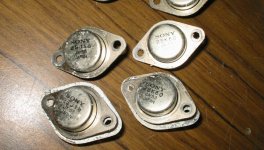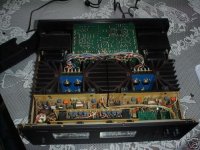"So enjoy, I have something else special coming up before year’s end."
NP is trying to do us in, JH6You.
NP is trying to do us in, JH6You.
Sigurd Ruschkow said:I sent Lovoltech an email yesterday asking for samples. No reply yet.
Well if Nelson does indeed currently have the current world's supply of that particular device, then I guess they wouldn't currently have any samples to hand out.
But ya never know. 🙂
se
Has Modulated Cascode ever been used in a production
amplifier? (with a power jfet like these)
I take it this is something pretty new?
to bad these jfets don't come in an easier to use case factor.
amplifier? (with a power jfet like these)
I take it this is something pretty new?
to bad these jfets don't come in an easier to use case factor.
Steve Eddy said:
Well if Nelson does indeed currently have the current world's supply of that particular device, then I guess they wouldn't currently have any samples to hand out.
But ya never know. 🙂
se
Steve,
NP will hand out samples beacuse he has all the samples🙂
PMA said:Maybe many small JFETs in parallel will do the job ... 😉
PMA,
NP has patent pending on that...
moe29 said:Has Modulated Cascode ever been used in a production
amplifier? (with a power jfet like these)
I take it this is something pretty new?
moe29,
Ditto...
tlf9999 said:
in my simulation it seems to be quite insensitive to what Q2 is. Here is mine, biased at about 1.7a runnging on two irfp140.
BTW, if you replaced the 11ohm resistor / lightbulb with a CCS, it will almost double the output voltage swing. so maybe the way to go is with three IRF devices, 🙂
tlf9999,
I think the way to go is with a complementary circuit and use the load between the two outputs. Double the parts, but quadruple the power & efficiency.
BTW, those JFETs seem to me prime candidates for a group buy. They may not be available as samples, but they ARE for sale. That's why they are in business 😉 .You guys could even outbid NP..😀
Jan Didden
There's lots of JFETs around for diy, if you can live with a 5A or so Id limit (or parallel them). SONY VFET amps from the 70's and 80'is have lots of them, and you find them often on eBay, like 4555's I think is the model number. TA-7's have 6 pairs each, although you would probably want that one in operating condition (I do!).
The nice thing about the complementary pairs is that you can take NP's circuit, make a complement and presto! you've got a bridge circuit. Quadrouple efficiency, MUCH less THD. Get creative guys!
Jan Didden
The nice thing about the complementary pairs is that you can take NP's circuit, make a complement and presto! you've got a bridge circuit. Quadrouple efficiency, MUCH less THD. Get creative guys!
Jan Didden
The nice thing about the complementary pairs is that you can take NP's circuit, make a complement and presto! you've got a bridge circuit. Quadrouple efficiency, MUCH less THD. Get creative guys!
Like a ONE stage balanced pushpull circlotron amp, DC coupled in and out with only perfectly complementary n-chanel fets and J-fets?
Circlomanen said:
Like a ONE stage balanced pushpull circlotron amp, DC coupled in and out with only perfectly complementary n-chanel fets and J-fets?
huh-I'll stay with tubes because of that........

and wait that New Year's surprise....
PMA said:Maybe many small JFETs in parallel will do the job ... 😉
You been wandering off the reservation, Pavel? 😀
se
Blues said:NP will hand out samples beacuse he has all the samples🙂
Well there ya go. Nelson's your Sample Simon. 🙂
PMA,
NP has patent pending on that...
This IS a joke, yes? 🙂
se
I would be surprised if a modulated cascode hasn't been thought
of before. I have no intentioning of patenting or trademarking
such a thing, and having published my remarks here, they are
now prior art.
As a phrase, "Modulated Cascode" goes over the heads of the
potential consumer. I would bury it in the brochure.
As a concept, it has its use, just as the balance adjustment has
in the PLH. You can use it to get cancellation of the second
harmonic, giving better specs, but it does not guaranty better
sound.
😎
of before. I have no intentioning of patenting or trademarking
such a thing, and having published my remarks here, they are
now prior art.
As a phrase, "Modulated Cascode" goes over the heads of the
potential consumer. I would bury it in the brochure.
As a concept, it has its use, just as the balance adjustment has
in the PLH. You can use it to get cancellation of the second
harmonic, giving better specs, but it does not guaranty better
sound.
😎
Like a ONE stage balanced pushpull circlotron amp, DC coupled in and out with only perfectly complementary n-chanel fets and J-fets?
Actualy that with SUSY on top is a VERY nice and simple solution to my problems with the Zenitron amp.
That is what Im going to build when I get my hands on some LU1014D.
That will most certainly solve any bias instabilities and greatly simplify the circuit.
Im soo impressed of Nelson Pass!!! Every article he writes is a door to a whole series of new thoughts and solutions in audio amp design.
Thank You Mr Pass!!! 🙂
Just for the record, picked from eBay. Yamaha B2, similar to B1?
"Yamaha B-2 V-fet audiophile quality stereo amplifier is finally up for grabs. Those of you who know how difficult it is to find this baby, well you wait is over. These were part of the Yamaha "Natural Sound" series and it certainly lives up to its name. It's sound is so sweetly produced by 2sj26 and 2sk76 vertical field effect (V-fets) transistors that have a warm tubelike sound. That, plus the fact that they are virtually non destructible (not subject to thermal runaway like bipolars) and have auto-biasing circuitry. Their odd order harmonics are similiar to triods and distortion is very low, .008 at 60 watts or below and rising just slightly above that at rated power of 100/watts channel. The heat sinks are so large and solid(study the pictures well) and cool the complimentary type v-fets so very well. Yamaha saw to it as well to give this amplifier so many features that were even today cutting edge! For instance, v.u. meters that have the capability to monitor either internally or externally, two inputs, two sets of speakers switches, every kind of protection circuitry and independent power transformers for each channel. The sound is so warm and accurate. It's easy to tell this amplifier is special. It is very heavy (58)lbs"
"Yamaha B-2 V-fet audiophile quality stereo amplifier is finally up for grabs. Those of you who know how difficult it is to find this baby, well you wait is over. These were part of the Yamaha "Natural Sound" series and it certainly lives up to its name. It's sound is so sweetly produced by 2sj26 and 2sk76 vertical field effect (V-fets) transistors that have a warm tubelike sound. That, plus the fact that they are virtually non destructible (not subject to thermal runaway like bipolars) and have auto-biasing circuitry. Their odd order harmonics are similiar to triods and distortion is very low, .008 at 60 watts or below and rising just slightly above that at rated power of 100/watts channel. The heat sinks are so large and solid(study the pictures well) and cool the complimentary type v-fets so very well. Yamaha saw to it as well to give this amplifier so many features that were even today cutting edge! For instance, v.u. meters that have the capability to monitor either internally or externally, two inputs, two sets of speakers switches, every kind of protection circuitry and independent power transformers for each channel. The sound is so warm and accurate. It's easy to tell this amplifier is special. It is very heavy (58)lbs"
Attachments
B2 going for $192.00
http://cgi.ebay.com/Yamaha-B-2-Ster...809711252QQcategoryZ39783QQrdZ1QQcmdZViewItem
http://cgi.ebay.com/Yamaha-B-2-Ster...809711252QQcategoryZ39783QQrdZ1QQcmdZViewItem
There is no reason not to parallel smaller JFETs. Gate capacitance will rise as the number of units increases, but that's no different from running a single monolithic unit with relatively high capacitance.
The Yamaha B-2 was/is a nice piece of audio gear. A buddy of mine used to own one. Whether he still has it, I do not know, as we've lost touch with one another. I believe it had a malfunctioning meter, but was otherwise playable. Other than the fact that you can't reliably source parts for service, they're certainly nifty if you can get one for a reasonable price. JFET output amps are rare.
Perhaps Lovoltech will heed the need and produce a complementary N/P amplification (as opposed to switching) pair of devices. Until then, we'll have to think in terms of quasi-complementary or other topologies that can make do with N-ch devices. But that's not so bad...even today tube folks manage to produce some truly dynamite gear with only "N" parts to work with.
Grey
The Yamaha B-2 was/is a nice piece of audio gear. A buddy of mine used to own one. Whether he still has it, I do not know, as we've lost touch with one another. I believe it had a malfunctioning meter, but was otherwise playable. Other than the fact that you can't reliably source parts for service, they're certainly nifty if you can get one for a reasonable price. JFET output amps are rare.
Perhaps Lovoltech will heed the need and produce a complementary N/P amplification (as opposed to switching) pair of devices. Until then, we'll have to think in terms of quasi-complementary or other topologies that can make do with N-ch devices. But that's not so bad...even today tube folks manage to produce some truly dynamite gear with only "N" parts to work with.
Grey
GRollins said:There is no reason not to parallel smaller JFETs. Gate capacitance will rise as the number of units increases, but that's no different from running a single monolithic unit with relatively high capacitance.
Yeah. Though JFETs do have an IDSS you have to consider and most parts won't dissipate much power so any parallel array of JFETs would have to be quite sizeable in order to do much with them.
It's something that's been in the back of my mind for a while and more recently I started thinking more seriously about it, but it's not looking too encouraging. And so far I haven't found anyone who's done it to any degree and I'm a bit hesitant to spend several hundred dollars on JFETs to test it out.
The 2N4856 seems to be a good candidate with a rather high typical IDSS, a low input capacitance and reasonable dissipation. But just to get an amp or so through them at just 12 volts would require a minimum array of at least 36 devices and at nearly $3 a pop that gets a bit pricey.
se
- Status
- Not open for further replies.
- Home
- Amplifiers
- Pass Labs
- Pass JFET Power Amplifier

